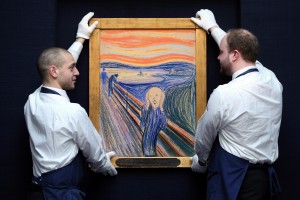By KELLY CROW
New York financier Leon Black paid Sotheby's nearly $120 million for Edvard Munch's masterpiece, "The Scream," according to several people close to the collector.
Now that the buyer has been identified, the new parlor game surrounding the iconic artwork will be guessing where it will end up. Mr. Black's long-term intentions for his Munch remain unclear. He sits on the boards of New York's Metropolitan Museum of Art and the Museum of Modern Art, setting up a potential tug of war between two of the country's most powerful art institutions. Neither owns a "Scream," aside from lithograph-print versions of it.
Few artworks have the world-wide celebrity of "The Scream," and it would immediately become a merchandising bonanza and huge attendance draw for any museum that displayed it.
It's easy to understand the work's appeal: Munch created four versions of "The Scream," but Mr. Black's is the only one not in an Oslo museum and the first to come up at auction. The work depicts a bald, skeletal figure in a blue shirt standing at a popular suicide spot on Oslo's horseshoe-shaped bay where people could often hear screams from a nearby insane asylum, according to art historians.
A spokesman for Mr. Black, 60 years old, declined to comment.
Mr. Black is one of a handful of billionaires whose lavish art spending has transformed the international art market in recent years, fueling the proliferation of art fairs and ratcheting up prices for all sorts of artworks. His $750 million art collection already includes drawings by Raphael and Vincent van Gogh, watercolors by J.M.W. Turner, Cubist paintings by Pablo Picasso and ancient Chinese bronzes. Three years ago, he paid Christie's $47.6 million for a Raphael chalk drawing, "Head of a Muse," a record auction price at the time for a work on paper.
The seller of "The Scream" was Petter Olsen, a Norwegian real-estate developer and shipping heir whose father was a neighbor of Munch's in the small Norwegian town of Hvitsten. Mr. Olsen said he sold the work in order to fund a hotel and museum of Munch's work near the Norwegian fjord where the artist painted.
Mr. Black gleaned an early interest in art from his mother and his aunt, Grace Borgenicht Brandt, a Manhattan art dealer who represented painter Milton Avery. In the late 1970s, Mr. Black became a buyout executive for Drexel Burnham Lambert and rose to become the billionaire chairman and chief executive of New York firm Apollo Global Management. His fortune, which Forbes said tops $3.4 billion as of March, increased when Apollo went public in March 2011. Apollo said it manages $105 billion in assets.
In 2006, Mr. Black teamed up with collector Ronald Lauder to buy a $38 million Ernst Ludwig Kirchner work, "Berlin Street Scene"—a record for that artist as well. In 2001, he and Mr. Lauder jointly paid Sotheby's $22.5 million for Max Beckmann's 1938 "Self Portrait with Hunting Horn." On Wednesday, Mr. Lauder said he has "always had great respect for Leon's taste and knowledge."
Unlike Mr. Lauder, who has put much of his collection on public display in his New York museum, the Neue Galerie, Mr. Black has always kept his art close to home. Dealers who have visited the Park Avenue apartment he shares with his wife, Debra, say it brims with art from an eclectic variety of styles and periods—from archaic Chinese vessels to Constantin Brâncuşi's sleek sculpture, "Bird in Space."
![[image]](http://si.wsj.net/public/resources/images/OB-TS580_0711sc_DV_20120711170034.jpg)
Getty Images
Edvard Munch
Mr. Black began collecting drawings as a teenager, and his walls are still dotted with clusters of framed sketches by Honoré Daumier, Georges Seurat, Paul Cézanne and van Gogh, dealers say. He also has purchased a few contemporary works by artists like Andy Warhol. (In March he and his wife gave his alma mater, Dartmouth College, $48 million to build a new visual arts center adorned with an Ellsworth Kelly wall sculpture.)
"I wish museum directors knew as much about art as Leon Black does," said Richard Feigen, an Old Master dealer who said he has known the collector for several decades and has sold him art. "Nobody has his wingspan."
Until recently, Mr. Black was still primarily known in the art world as a collector of drawings, a field that's been largely overlooked by the recent influx of billionaire art buyers because these works tend to be smaller and harder to instantly identify than a colorful, wall-power painting. In some ways, "The Scream" represents a perfect hybrid because it is a pastel on board—containing all the chalky immediacy of a work on paper—and yet its imagery is well known by the masses.
Whatever his reasons for wanting "The Scream," Mr. Black competed hard to win it. During Sotheby's May 2 sale in New York, auctioneer Tobias Meyer kicked off the bidding for the work at $40 million, and five bidders from the U.S. and China joined in. Among them was Mr. Black, who fielded his telephone bids through Charles Moffett, Sotheby's executive vice president and vice chairman of its world-wide Impressionist, modern and contemporary art department. As the price topped $80 million, the fight came down to Mr. Black and another telephone bidder, whose bids began to waver and lag as the price climbed higher still. Mr. Black's bids came quickly, suggesting less hesitation.
When the bidding crossed the $100 million mark, an auction first, Mr. Meyer adjusted his tuxedo jacket at his rostrum and said, "Can I say I love you?" The hundreds of people packed into the house's York Avenue saleroom chuckled. When the gavel finally fell, Mr. Moffett smiled, whispered his congratulations to Mr. Black and hung up.
via online.wsj.com


















